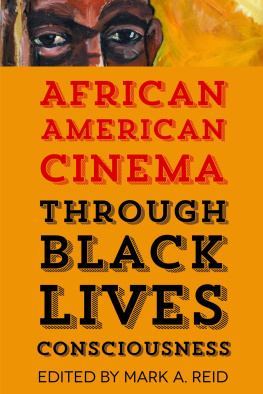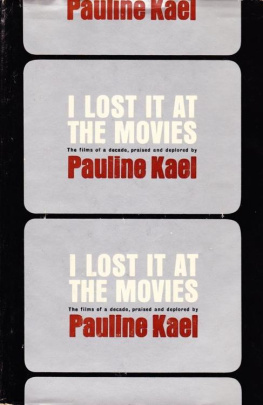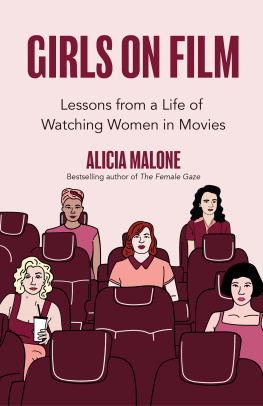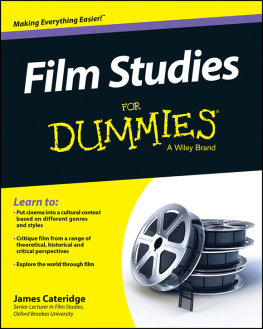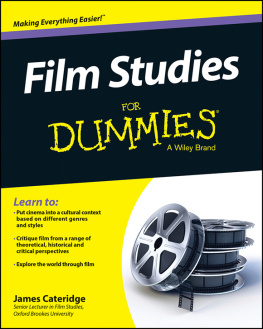for Linda, a fighter
Published in 2002 by
Routledge
270 Madison Ave,
New York NY 10016
Published in Great Britain by
Routledge
2 Park Square, Milton park,
Abingdon, Oxon, OX14 4RN
Routledge is an imprint of the Taylor & Francis Group.
Transferred to Digital Printing 2010
Copyright 2002 by Routledge
All rights reserved. No part of book may be reprinted or reproduced or utilized in any form or by any electronic, mechanical, or other means, now known or hereafter invented, including photocopying and recording or in any information storage or retrieval system, without permission in writing from the publishers.
Design and typography: Jack Donner
Library of Congress Cataloging-in-publication Data
Black, Joel, 1950-
The reality effect: film culture and the graphic imperative / Joel Black.
p. cm.
ISBN 0415937205 ISBN 0415937213 (pdk.)
1. Realism in motion pictures. I. Title.
PN1995.9.R3 B59 2001
791.43'612dc21
2001019642
Publisher's Note
The publisher has gone to great lengths to ensure the quality of this reprint but points out that some imperfections in the original may be apparent.
The Filmed Century
The twentieth century is on film. It's the filmed century. You have to ask yourself if there's anything about us more important than the fact that we're constantly on film, constantly watching ourselves. The whole world is on film, all the time. Spy satellites, microscopic scanners, pictures of the uterus, embryos, sex, war, assassinations, everything.
Don DeLillo, The Names
Now that the twentieth century is behind us, what does it mean to refer to it as the filmed centurythe first century to be documented, from start to finish, on film? How significant is it that all sorts of events are being graphically preserved as never before, that phenomena of all kinds never previously recorded are now showing up on film, from newly discovered galaxies at the edge of the universe to PET and CAT scans, sonograms and mammograms, and confessions by heads of state about their sex lives? "Like no previous generation," writes James Gleick, "we see our history in our mind's eye: Neil Armstrong stepping onto the moon; Lee Harvey Oswald taking a bullet in the gut; the century's cyclonic hurricanes and mushroom clouds."reality, so that reality is no longer what it used to be? And if so, how is such a transformation itself to be documented?
If answers to these questions aren't readily available, it's because the twentieth century's definitively filmic natureentailing a peculiar mix of reality and artifice, high and low culturehas yet to be generally acknowledged. Ironically, the impact of film on culture may have been more widely recognized before the advent of the academic discipline of film studies, and even before the medium's appropriation by the arts and the entertainment industry. For film came into being, after all, in the middle of the recording revolution, midway between photography and phonography. Even before the medium was invented, as Siegfried Kracauer noted, the forerunners of film theory took it "for granted that film would continue along the lines of photography" and "looked forward to what we have come to label newsreels and documentaries-films devoted to the rendering of real-life events." This "insistence on recording,"
The "film-as-art idea" gained wide currency especially in the 1950s, after the breakup of the studio system and the rise of independent filmmaking.
By shifting the emphasis from content to form, theoretically trained academicians brought a new sophistication to film studies, but they also tended to limit the field's object of study to cinema as art and entertainment at a time when visual media were coming to pervade every sector of modern life.
The impact of the new generation of postrepresentational reality effects has yet to be gaugedthose produced by the twentieth-century recording technology of cinema, which at least continue to engage the But we need not anticipate future developments. The eye and other senses are already habitually overstimulated and overwhelmed by the formless explosion of mass cultural "in-formation" filtering down from the new media technologies with their drive toward hyperindexicality into more conventional forms of cinematic and other visual experience. Consider the vastly expanded content made possible by new cinematographic techniques (instant replay, slow motion, time-lapse photography, digitalization) and by the enhanced graphic displays of the new technologies (video media and video games, the Internet, spy satellites, surveillance cameras). And we shouldn't forget those exhibitionistic Web-cam sites (e.g., JenniCam, Web-Dorm.com) that enable anyone to turn their lives into reality TV or EdTV (as in the 1998 movie of that name), so that everyone can peer into the most intimatebut more often the most banalmoments of their lives.
It used to be that only movies were on film; now the whole world is. More than ever, visual technologies seem intent on striving for what Kracauer called "the status of total record." And not only does it seem at the start of the new century that everything is on film or video (although it is unclear, given the unstable nature of videotape and other recording media that began replacing film at the century's end, how long this recorded material will remain viewable),
The fact is that him is the medium of modern mass culture. Not only is it consumed by the masses more than any other medium, but in no other commodity does mass culture itself provide the content to the degree it does in film. One need only think of all the product placement in movies, the tie-ins with fast food, soft drinks, and sports cars that are increasingly transforming blockbuster films into nonstop advertisements, and the increasing instances of cross promotion in the wake of media megamergers.in which families share fantasies by taking rides based on past movies and previewing movies that may end up as future fantasy rides.
Faced with the impact of movies and visual media on mass culture, some critics have gone from the extreme of treating film exclusively as an elitist art form to the opposite extreme of considering it merely as a form of mass entertainment. Neal Gabler may be right that movies and popular culture have overwhelmed American life, but his 1998 book Life the Movie (which is really not about movies but about how American life has assumed the characteristics of the generic motion picture) gives the impression that mainstream movies are the only kind of film affecting viewers.not only classic documentaries such as Nanook of the North and Triumph of the Will, but also memorable newsreel footage of World War II military campaigns and early nuclear-weapons tests, filmed and taped records of the Vietnam and Gulf Wars, and unedited amateur footage such as Abraham Zapruder's home movie of John F. Kennedy's assassination or George Holliday's videotape of Los Angeles police officers beating Rodney King. And with the growing reliance on satellite surveillance and security camera footage, the presence of a human operator behind the camera has become increasingly superfluous. Such graphic, evidentiary instances of cinema verit cannot be reduced to mass entertainment, although they are often quickly appropriated by the commercial media.


